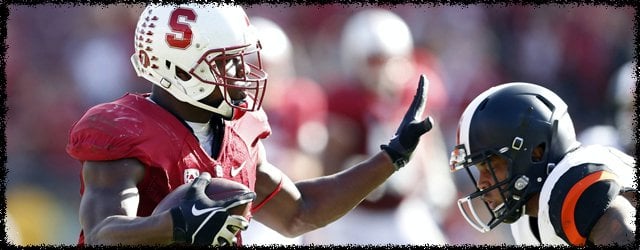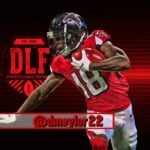Team-by-Team Draft Review: Green Bay Packers

Green Bay’s offense has been one of the best in the league for years and due to that, has become a hotbed of fantasy producers. The Packers didn’t enter the NFL draft with many needs among offensive skill positions but added a few players with long term potential nonetheless. Let’s take a look at each of them.
Ty Montgomery, WR (Round 3, Pick 94 overall)
Going into the draft, wide receiver was among the positions the Packers were most set at. Jordy Nelson and the newly re-signed Randall Cobb have cemented themselves as one of the premier tandems in the league and it’s difficult to find a young receiver with more potential than last year’s second round pick, Davante Adams. Even the fourth and fifth receivers on the Green Bay depth chart, Jeff Janis and Jared Abbrederis, both project to potentially contribute at some point.
So why did the Packers decide to take a receiver? The only logical reason must be that they simply couldn’t pass up the value.
Before dissecting Montgomery’s game, let’s first have a quick history lesson. Going into the 2015 NFL Draft, Packers general manager Ted Thompson had taken five wide receivers in the second or third rounds of drafts over the previous nine years. Those five wide outs were Greg Jennings in 2006 out of Western Michigan, James Jones in 2007 out of San Jose State, Nelson in 2008 from Kansas State, Cobb in 2011 out of Kentucky and finally Adams a year ago out of Fresno State. Most would say that’s a pretty impressive string of second and third round success at one position.
Much like Jennings (6’-0”, 195 pounds), Jones (6’-1”, 210), Nelson (6’-3”, 215) and Adams (6’-1”, 210), Montgomery fits in the mold of receivers Thompson has brought to Green Bay. He’s 6’-0, 221 pounds and wasn’t highly thought of by most draftniks.
[am4show have=’g1;’ guest_error=’sub_message’ user_error=’sub_message’ ]
While none of these similarities should suggest Montgomery will make an impact for the Packers or the dynasty owners that take him in rookie drafts, it does suggest fantasy players should trust Thompson’s ability to identify wide receiver talent on the second day of the draft that fits into what Green Bay is trying to do on offense. Thompson’s track record on the subject alone should at the very least give dynasty owners pause when considering Montgomery’s potential value in dynasty leagues.
Montgomery does a lot of things well on the field. He was a bit of a Swiss army knife while at Stanford, lining up all over the formation including as a split receiver, in the slot, at running back and even at quarterback at times. A dynamic runner with the ball in his hands, the Cardinal coaching staff took every opportunity to get him the ball in space.
The most impressive part about Montgomery’s game is his skills as a returner – he averaged 27.4 yards per kick return in his four years in college and scored five special teams touchdowns. Although he only returned 12 punts in his time at Stanford, two of them were returned for scores.
Like all prospects, there are some flaws in Montgomery’s game. His route running isn’t sharp and he was primarily only asked to run underneath routes while in college which will have to change to play with Aaron Rodgers. Montgomery also struggled at times holding onto the ball, dropping very catchable passes because he let the ball get into his body rather than snatching it with his hands.
Although he proved at the combine that he’s not particularly fast, posting a 4.55-second 40 time, and needs to learn to run better routes and hold onto the ball, Montgomery has potential in the Green Bay offense. At the very least, he should immediately become the Packers’ primary kick and punt returner and keep Cobb from having to take the punishment that return men have to endure.
Overall, even though Montgomery is buried behind a trio of quality wide outs and will have to compete with two other young draft picks in training camp this summer, it’s very unlikely that Thompson would use a third round pick on a fringe player he and the coaching staff doesn’t have a plan for. He’ll likely fill the role of fourth wide receiver on offense (which can turn into a fantasy contributor in the event of an injury to a top-three receiver) and full-time return man. He has low-end WR2 potential as long as he’s in Green Bay but dynasty owners should remember that it may take a few years to develop into such a player and he has a lot of improvement to do to reach his upside. All in all, there are certainly worse lottery tickets in the late rounds of rookie drafts.
Brett Hundley, QB (Round 5, Pick 147 overall)
Going into the draft, my feelings were lukewarm on Hundley – that was when most considered him a second to third round pick in the draft and thought he’d end up in place where he would be asked to compete for a starting job, however.
Although Hundley didn’t play from under center much in college and has some flaws, he does some things well and certainly looks the part of an NFL quarterback at 6’3” tall and 226 pounds. In his time at UCLA, he got better each year at playing from inside the pocket and made good decisions with the ball, throwing just 14 interceptions in his final two years on campus. His solid numbers as a passer paled in comparison to the stats he put up as a runner however, as he scored 30 times on the ground in three years and racked up 1,747 yards rushing.
Although his statistics suggest running the ball was a strength of his, Hundley showed some glaring weaknesses when he tucked the ball while in college. Often relying too heavily on his legs, he would regularly tuck the ball despite having a clean pocket and when he chose to throw while on the move, he was incredibly inaccurate which is far from what the Packers’ current starter does regularly on Sundays.
Overall, there isn’t a better place for Hundley in the NFL. He’ll have the opportunity to learn from one of the best quarterback coaches in the game in Mike McCarthy and pick the brain of an MVP as he watches from the sideline. While that will likely be good for his career, it’s not going to help anybody’s fantasy team.
At this point, Hundley likely only has value in very deep leagues with large rosters or long term developmental roster spots. Unless you’re comfortable stashing him for at least three years before seeing any return on the investment, he’s not worth drafting in most situations.
Aaron Ripkowski, FB (Round 6, Pick 210 overall)
Ripkowski is an old-school fullback in the mold of current Packer John Kuhn. He won’t help your fantasy team much other than blasting holes for Eddie Lacy.
Kennard Backman, TE (Round 6, Pick 213 overall)
To be completely honest, I’d never seen Backman play until his name was called in the sixth round and I went to my computer to see what I could find on him. At 6’-3” tall and 258 pounds, he played throughout the formation at tight end, H-back and in the slot. Although he didn’t appear to run many different routes, he excelled running the seam route and finding openings in zone defenses. Playing with a below average quarterback, he was routinely forced to catch errant passes and looked good catching the ball at its highest point and away from his body.
From everything I read on Backman, he has some improving to do as a blocker and his strength is only average which could keep him from seeing the field early in his career. Although that may be true, the film shows a raw route runner with size and athletisism.
Despite only catching 39 passes for 399 yards and three touchdowns last year at UAB and being a relative unknown before being selected by the Packers, dynasty owners should keep Backman on their radar going forward. Due to the limited talent at tight end in Green Bay with only Richard Rodgers and Andrew Quarless on the depth chart, there’s a real (albeit small) chance he could contribute for the Packers. Although he shouldn’t be considered in rookie drafts, Backman could prove to be a name worth remembering for future waiver wire use.
John Crockett, RB (Undrafted Free Agent)
Although he wasn’t drafted, Crockett is worth mentioning here because of his potential to perhaps someday become a contributor for the Packers. A big running back (6’-0”, 217 pounds) with a quick burst and good vision, it’s not impossible that the four time national champion from North Dakota State makes Green Bay’s roster as a backup. Although James Starks is firmly in place as the primary backup to Eddie Lacy, Crockett could find his way onto the field if an injury occurred. He’s probably not worth drafting except in deep leagues, but his is another name worth monitoring through training camp.
[/am4show]
- League Tycoon: Dynasty Salary Cap Fantasy Football - December 15, 2023
- Final Dynasty Rookie Report Card: Wide Receivers, Part Two - March 22, 2023
- 2023 NFL Scouting Combine: Offensive Player Dynasty Review - March 10, 2023


































































